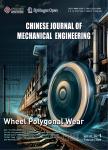Investigation on Uniaxial Tensile Instability of USIBOR1500 Steel Sheets at Elevated Temperature
Investigation on Uniaxial Tensile Instability of USIBOR1500 Steel Sheets at Elevated Temperature作者机构:College of Mechanical Engineering Tongii University Shanghai 201804 China College of Mechanical and Electrical Engineering Shanghai Second Polytechnic University Shanghai 201209 China
出 版 物:《Chinese Journal of Mechanical Engineering》 (中国机械工程学报(英文版))
年 卷 期:2010年第23卷第1期
页 面:94-99页
核心收录:
学科分类:080503[工学-材料加工工程] 08[工学] 0805[工学-材料科学与工程(可授工学、理学学位)] 0802[工学-机械工程] 0814[工学-土木工程] 080201[工学-机械制造及其自动化] 082301[工学-道路与铁道工程] 0823[工学-交通运输工程]
主 题:USIBOR1500 uniaxial tensile instability uniform strain necking rate
摘 要:In the sheet forming process with stretch, diffuse instability and localized instability usually occur in the process one after another. The necking rate has a great impact on the instability process and the forming limits of the rate sensitive material, such as USIBOR1500 steel sheets at elevated temperature. The available reports about this steel mainly focus on hot uniaxial tensile, martensitic transformation and forming process, but there are few investigations on instability behavior and forming limits. Based on Inoue Kachiro's flow stress constitutive model at elevated temperature, combined with Swift's diffuse instability rule and Hill's localized instability nile, the relation is theoretically deduced between the diffuse necking rate along with the localized necking rate and the exponent of strain rate sensitivity together with the strain rate in the case of the USIBOR1500 steel sheets at elevated temperature. According to the time-temperature characteristics of the hot stamping process, tensile tests of the steel sheets were carried out on Gleeble3800, and the stress-strain curves were obtained at different temperatures and different strain rates. Then the values of the exponent of strain rate sensitivity and the hardening exponent were obtained through fitting the curves by least squares. The tests also helped to provide the distribution laws of the major strain of the specimens and the uniform strains as well as the necking width. The uniform strains obtained from the tests are matched well with the theoretical calculations.



